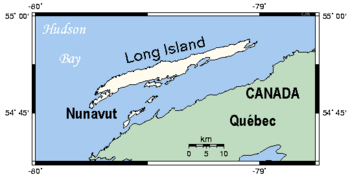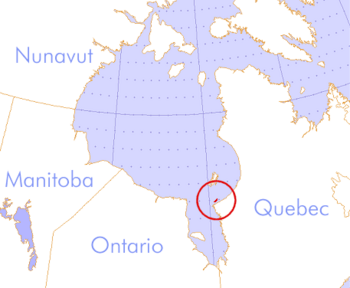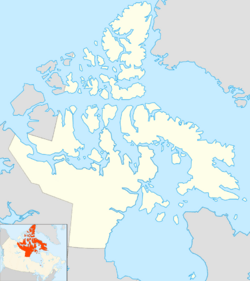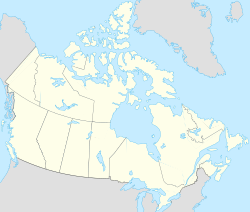Long Island (Hudson Bay, Nunavut) facts for kids

Long Island, Nunavut
|
|

Location in Hudson Bay
|
|
| Geography | |
|---|---|
| Location | Hudson Bay |
| Coordinates | 54°52′N 79°25′W / 54.867°N 79.417°W |
| Archipelago | Canadian Arctic Archipelago |
| Area | 168 km2 (65 sq mi) |
| Administration | |
| Nunavut | Nunavut |
| Region | Qikiqtaaluk |
| Demographics | |
| Population | Uninhabited |
Long Island is a fascinating, uninhabited island located in Hudson Bay, Canada. It's part of the Qikiqtaaluk Region in Nunavut, Canada's largest and northernmost territory. This island is found off the coast of Quebec and covers an area of about 168 square kilometers. That's roughly the size of a medium-sized city!
Long Island is one of many islands that make up the vast Canadian Arctic Archipelago. These islands are known for their cold climate and unique landscapes.
Contents
Where is Long Island Located?
Long Island sits in the southeastern part of Hudson Bay. This huge body of saltwater is often called an inland sea because it's almost completely surrounded by land. The island's exact location is 54°52'N latitude and 79°25'W longitude. This means it's quite far north, close to the Arctic Circle.
A Look at Hudson Bay
Hudson Bay is a very important part of Canada's geography. It's connected to the Atlantic Ocean through the Hudson Strait. The bay is famous for:
- Its cold waters, which are often covered in ice for many months of the year.
- Being home to diverse wildlife, including polar bears and seals.
- Its role in the history of exploration and trade in Canada.
Why is Long Island Uninhabited?
Long Island, like many islands in the Canadian Arctic, has no permanent human residents. There are several reasons for this:
- Harsh Climate: The island experiences extremely cold temperatures for most of the year. Winters are long and dark, and summers are short and cool.
- Remote Location: It's far from major towns and cities, making it difficult to access and live on.
- Limited Resources: The land is mostly tundra, meaning it's frozen for much of the year. This makes it hard to grow food or build large settlements.
Life in the Arctic
Even though Long Island is uninhabited by humans, it's not empty! The Arctic environment supports a variety of plants and animals that have adapted to the cold.
Arctic Wildlife
While specific animals on Long Island aren't detailed, islands in Hudson Bay and the surrounding Arctic are often home to:
- Polar Bears: These magnificent predators roam the ice and land, hunting seals.
- Seals: Various types of seals, like ringed seals and bearded seals, live in the waters around the island.
- Arctic Foxes: Small, clever predators that hunt rodents and birds.
- Migratory Birds: Many bird species visit the Arctic during the summer to nest and raise their young.
Unique Plant Life
The plant life on Long Island would be typical of the tundra biome. This includes:
- Mosses and Lichens: These tough plants can grow on rocks and in thin soil.
- Small Shrubs: Low-growing bushes that stay close to the ground to avoid strong winds.
- Wildflowers: Brightly colored flowers that bloom quickly during the short summer.
Part of the Canadian Arctic Archipelago
Long Island is part of a huge group of islands called the Canadian Arctic Archipelago. This archipelago includes thousands of islands, making up a significant portion of Canada's landmass.
What is an Archipelago?
An archipelago is simply a group or chain of islands. The Canadian Arctic Archipelago is one of the largest in the world. These islands are mostly covered in ice and snow, with vast areas of tundra.
Importance of Arctic Islands
These islands are important for several reasons:
- Ecosystems: They provide unique habitats for Arctic wildlife.
- Research: Scientists study the climate, geology, and wildlife of these islands.
- Indigenous Culture: For thousands of years, Inuit people have lived in and traveled through parts of the Arctic, adapting to its challenges.
Long Island, though small and uninhabited, is a fascinating piece of Canada's vast and wild northern landscape. It reminds us of the incredible natural beauty and harsh conditions found in the Arctic regions of our planet.



